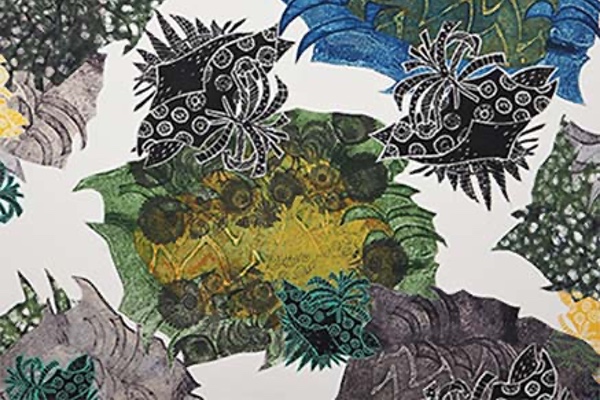Christina Massey is a Brooklyn-based abstract and mixed-media artist whose work has been featured in many solo and group exhibitions in the United States. Massey, who was born in 1979, is passionate about the preservation of our environment and our relationship with nature. She is also committed to addressing the equality of women’s rights and giving voice to lingering gender stereotypes. She holds a BFA from California State University in Chico. See her work featured in WTP Vol. VIII #5.
Interview with Christina Massey
By Jennifer Nelson, WTP Feature Writer
Nelson: How and when did you become interested in pursuing art as a profession?
Massey: I wanted to be an artist before I ever really understood what that meant. I grew up in a not particularly “artsy” part of the country and didn’t have access to galleries or museums or anyone to look up to for guidance. I earned my BFA at California State University, Chico which was the first formal training I’d ever had, but Chico is not a big city, and I had no access to contemporary art outside of just what the students and staff were creating. The only examples I had of professional artists were my professors, who encouraged me to continue on for an MFA and pursue a career in teaching. For a very short while I did consider that career path. However, in the fall of my senior year, 9/11 happened, which obviously changed everything. I had made up my mind prior to that event that I would move to New York City after graduation, originally with the idea that I’d work to save up money for a few years to apply to graduate school. I did still end up moving to NY, though finding any sort of job that would allow me to save anything was naive and unrealistic. For the first time in my life though, I was able to go to openings and museums and see and meet living working artists that were not teachers, and I knew that was the right path for me and was determined to make art my profession. I struggled for many years working jobs and trying to get my art out there, and when the Recession hit, in a way, it was a relief. It forced me to become the professional I am now. I didn’t have any other option, there were no jobs for me to fall back on as a safety net, so I just had to make it work as an artist.
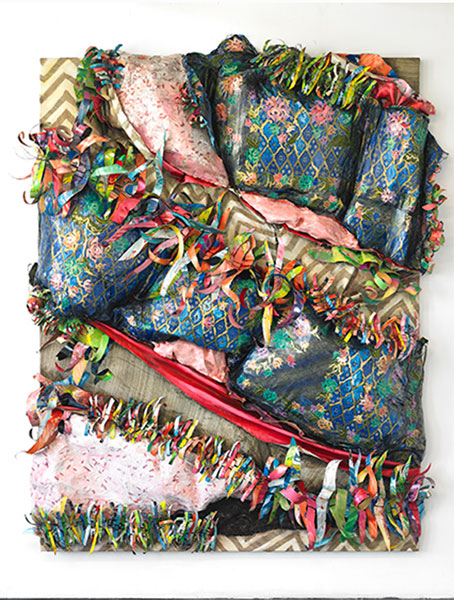
Nelson: In Crafty Collaboration and Collusion, you combine painting with sculpture in large mixed-media works that rely on the unusual of aluminum from craft beer cans in addition to fabric and paper. Please describe the processes and materials you used to create this series, as well as the meaning behind the title.
Massey: Those are extremely labor-intensive works. When I first started creating that series, I had just moved into a new larger studio, about twice the size of my previous one and wanted to challenge myself to work bigger than I had for quite some time. I wanted to push that conversation of painting versus sculpture slightly further to the painting side, using stretcher frames and reintroducing canvas into my work. That begins with fencing, canvas and molding wire, creating a landscape of sorts with peaks and valleys which is all completely hand stitched together. From there, additional fabrics, papers, strips of repurposed aluminum begin to be hand stitched in as well, covering the fencing almost like paper mâché. Everything is then sealed and primed, front and back, which I then paint on. Additional materials are added as I feel necessary and the work starts to come together.
The news cycle at the time was dominated by the “collusion” debate. That word caught my attention in its similarities to how the word “crafty” can sometimes be interpreted, particularly when referring to women. It can mean devious, sly, cunning, hiding something, and not entirely truthful. The whole craft versus fine art debate and conversation is one that I am often inspired by, particularly with its link and connection to female artists. By using materials like craft beer cans throughout my work, I play with those notions of the word craft being used in one rather male-dominated field to elevate and distinguish its product and to diminish and devalue in another. In this series, the works “hide” this more “masculine” material a little, people often at first confusing them for paper. When looking at them closely, one begins to notice the bar codes and text beneath the layers of paint, the imperfections in the weavings and patterns, and if stepping back, their size starts to come into consideration. I teasingly call them “mattress sized” as I wanted the viewer to have that physical connection to the work, where this bed-like form can appear both soft and inviting yet dangerous and sharp as the country was in the peak of the #MeToo movement.
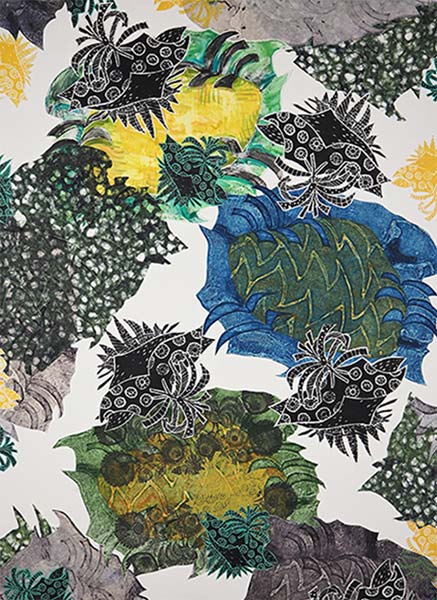
Nelson: In 2017, you created Carbonation Collection at a three-month printmaking workshop in New York City. Can you talk about your experience at the EFA Robert Blackburn workshop, as well as the techniques and materials used in this monoprint collages series?
Massey: That was such an incredible experience. Eight artists were invited to use their facilities for a summer and offered a series of courses and workshops learning various techniques within the realm of printmaking. Typically, artists will find one that best suits their work, and focus on that technique during that time. I loved just about everything however, so I began incorporating several techniques into my process, focusing mostly on processes like collagraph, linocut and silkscreen. For my collagraph plates, I used canvas board and masking techniques so that the plates had an organic form and gave the prints a painting-like quality. The linocut plates were made out of doing drawings of my sculptures, and those in turn were also used to create silkscreen prints where I could play with the scale and size of the other blocks. I liked the idea creating a series of the works that have a connection through the use of the same print, highlighting their material and process use, but that are completely unique and one of a kind.
As so much of my work is inspired by textiles, I wanted this series to have a very fabric-like feel to them, and almost vintage appearance. Their titles again hint at my love of words that can have multiple meanings. Carbonation refers to the aluminum cans used in my work. Since many of my plates were drawn from those sculptures, I wanted to make a linguistic connection, and at the same time, refer to the carbonation of our environment. The term “collection” was used as a reference to the fashion industry, and how they produce “collections” versus series that are usually inspired by the seasons. I question how climate change is affecting this potentially, as we tend to associate certain colors with seasons, and if the experiences of those seasons is changing, how that changes our consumer choices. Each piece has a separate title, inspired by these traditional and new marketing schemes often used to entice consumption, so one might be “Carbonation Collection: Fall” and another “Carbonation Collection: Pumpkin” or “Ski” which are essentially made-up seasons.
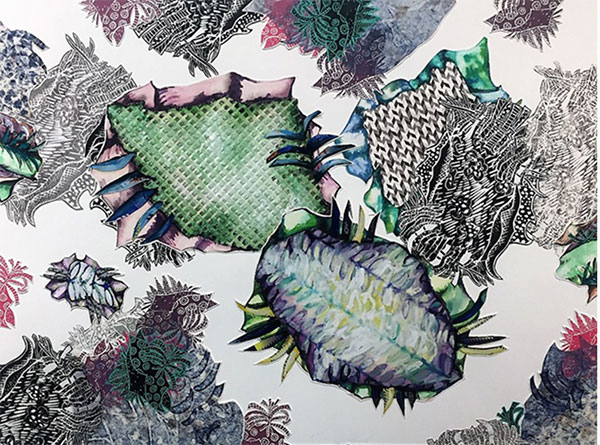
Nelson: How does nature inspire you in such works as “Midnight Floral,” a mixed-media collage that uses such techniques and materials as linocut, image transfer, silkscreen, watercolors and acrylics?
Massey: This series is kind of a mixture of the woven paintings thought process and the monoprint collages in a way. I decided to cut up and repurpose some older mixed-media watercolor pieces and combine those with the techniques I had learned at the fellowship at the EFA Robert Blackburn Printmaking Workshop. The original watercolors were combined with the same materials I used to create the artisanal sculptures; they have fabrics, papers and aluminum in them, and were two-dimensional counterparts to that series. Their forms are abstract but take inspiration from bugs and floral pods.
Because I often repurpose older work into new work, there’s always this notion of time that I’m thinking about. I often make references in my titles to those times of day or seasons when the light changes or time changes. I think time is fascinating, and especially how nature records time and responds to time.
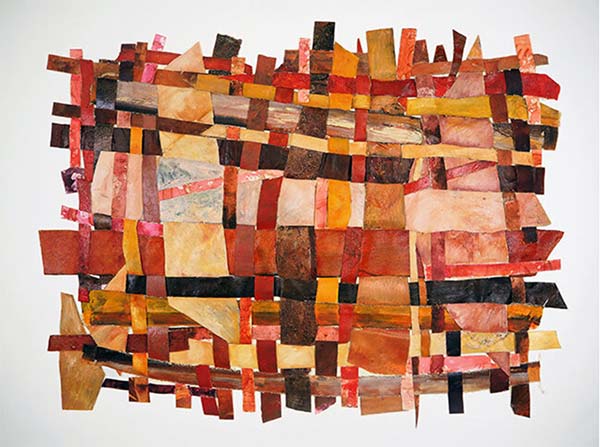
Nelson: You created the Woven Paintings series by cutting up past artworks on canvas, linen and paper and hand weaving them together again, then mounting them on paper. How did you decide which of your original artwork would be used in this series, and how did you become interested in weaving?
Massey: This series started in 2009. I had been laid off from a job and had to move my studio to my living room, as well as create from what I had available to me. At that point, I had already been largely repurposing my artworks, turning paintings into large installations which I now had no space for. So, the large installation work then became two-dimensional again largely out of necessity. Creating them felt very therapeutic, and I kind of fell in love with the meditative quality of the process. The weaving began very simplistic, just an over and under technique, and eventually I did learn how to use a floor loom, however I still enjoy the more simplistic process more and use it frequently with other materials like aluminum and wire. It’s a great go-to if I’m ever needing a bit of a mental break, weaving helps me be productive, and allows my mind the rest it needs to then approach other aspects of my work again with a different mindset.
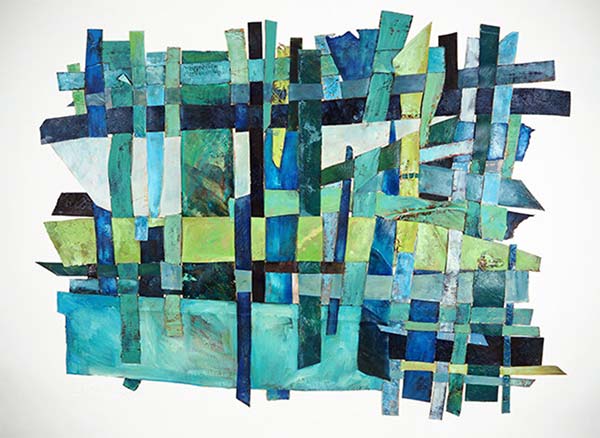
Nelson: How have you addressed the equality of women’s rights and given voice to lingering gender stereotypes?
Massey: I try to work with like-minded people as much as possible, people who believe strongly in supporting and representing the work of a diverse group of underrepresented artists. I love working with women-owned galleries, curators, many of my collectors are also women, and it is women who most often write about my work and support my career. I think it’s just as important to support the women working in all aspects of the art world as the artists themselves. When we have more women put into positions of power, be that through curation, collection or publications, we will see and appreciate a wider variety of artists work as valuable and important. We have for so long only had one point of view and the market reflects that. As we change who is collecting, creating and supporting the arts, we change how it is overall valued and open up opportunities for more people.
I play with stereotypes quite a bit in my work, mingling so called “craft” and “fine art” and challenge it by using stereotypically “male” materials like beer cans. I like that this sometimes makes people laugh and surprises them. I think of my aesthetic as rather feminine, yet this throws a wrench into that idea of what feminine is. When I use colors associated with genders like pink and blue, they also have symbolic meaning for me. The pinks I use are very fleshy and bodily as our identities as women are so often tied to our physical appearance. The blues I use are often watery in appearance, and flow through a work like a river in a landscape.
I also curate, often all women, or at least mostly women exhibitions and created the WoArtBlog, an Instagram account that features daily the work of female-identifying artists as a way to support our larger community. In fact, I am co-curating a show in recognition of the 100th Anniversary of women gaining the right to vote, which opens this September at the Pelham Art Center, in Pelham, NY. I am very excited to share with the world this exceptional group of artists.
Nelson: How do you see your artwork evolving in the future?
Massey: Often these big social and economic events do end up greatly influencing my work, as happened after 9/11 and the Recession, so I imagine my work will make a shift again as we learn to live with and recover from this pandemic. Where my personal living, working and financial situations changed dramatically after both those events, this time has been different. All my shows, talks and events were cancelled at first, but then I was invited to do several benefit shows online, and to my surprise, I am incredibly grateful that people are still buying art, and from living artists no less. It remains to be an extremely challenging time for artists, but there seems to be more awareness and support this time which I am very grateful for.
The biggest shift so far is that I have been deeply inspired to use my art to entice action and change for the greater community. This has developed through two current projects.
First, during the peak of COVID-19 cases in New York City and start of the shut-down, I created a call to action for artists to create artworks together collaboratively through the mail, to not only feel more connected while social distancing, but to support the ailing US Postal Service which we so desperately need during a pandemic and election year. I called it the USPS Art Project/Artists for the USPS. There are now somewhere around 400 different collaborative artworks that have been made all via the postal service by probably around 500 to 700 different artists. Since many artists did more than one collaboration, it is hard to know the exact number. These are now turning into a hybrid traveling/theme exhibition and it has really inspired me and invigorated my personal practice. You learn so much by working together with another artist, seeing how they approach the material and work, it has been a fun challenge during these strange times that I feel will influence my future work to come.
Additionally, I banded together with some like-minded artists to create an initiative that would support other artists in need. I struggled during those years after 9/11 and the Recession, I really wanted to be able to use my art as a way to help others. We created what is called the ArtistsXChange, which will officially launch this fall as a way to raise funds for non-profit organizations that directly fund and support artists in need.
Copyright 2020 Woven Tale Press LLC. All Rights Reserved

